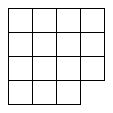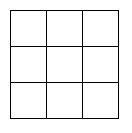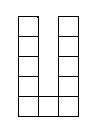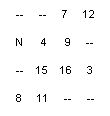

2. A boy has the following seven coins in his pocket: 2 pennies, 2 nickels, 2 dimes, and 1 quarter. He takes out two coins, records the sum of their values, and then puts them back with the other coins. He continues to take out two coins, records the sum of their values, and puts them back with the other coins. How many different sums can he record at most?
| 3. Suppose all the counting numbers are arranged in columns as shown at the right. Under what letter will the number 1000 appear? |

|
4. Twelve people purchased supplies for a ten-day camping trip with the understanding that each of the twelve will get equal daily shares. They are then joined by three more people, but make no further purchases. How long will the supplies then last if the original daily share for each person is not changed?
5. A bag contains 500 beads, each of the same size, but in 5 different colors. Suppose there are 100 beads of each color and I am blindfolded. What is the least number of beads I must pick before I can be sure there are 5 beads of the same color among the beads I have picked blindfolded?
6. If 20 is added to one-third of a number, the result is the double of the number. What is the number?
| 7. Each of the boxes in the figure at the right is a square. How many different squares can be traced using the lines in the figure? |

|
8. A woman spent two-thirds of her money. She lost two-thirds of the remainder and then had $4 left. With how much money did she start?
9. If a number ends in zeros, the zeros are called terminal zeros. For example, 520,000 has four terminal zeros, but 502,000 has just three terminal zeros. Let N equal the product of all natural numbers from 1 through 20: N = 1 x 2 x 3 x 4 x ... x 20. How many terminal zeros will N have when it is written in standard form?
10. If I start with 2 and count by 3's until I reach 449, I will get: 2, 5, 8, 11, ... , 449 where 2 is the first number, 5 is the second number, 8 is the third number and so forth. If 449 is the Nth number, what is the value of N?
11. The perimeter of a rectangle is 22 inches and the inch-measure of each side is a natural number. How many different areas in square inches can the rectangle have?
12. A man drives from his home at 30 miles per hour to the shopping center which is 20 miles from his home. On the return trip he encounters heavy traffic and averages 12 miles per hour. How much time does the man take in driving to and from the shopping center?
| 13. In the addition problem at the right, each letter stands for a digit and different letters stand for different digits. What digits do the letters H, E, and A each represent? |

|
14. The product of two numbers is 144 and their difference is 10. What is the sum of the two numbers?
15. The XYZ club collected a total of $1.21 from its members with each member contributing the same amount. If each member paid for his or her share with 3 coins, how many nickels were contributed?
16. During a school year, a student was given an award of 25cents for each math test he passed and was fined 50cents for each math test he failed. At the end of the school year, the student had passed 7 times as many tests as he had failed, and received $3.75. How many tests did he fail?
17. Arrange the digits 1, 1, 2, 2, 3, 3, as a six-digit number in which the 1s are separated by one digit, the 2s are separated by two digits, and the 3s are separated by three digits. There are two answers. Find one.
18. Suppose five days before the day after tomorrow was Wednesday. What day of the week was yesterday?
| 19. In the diagram at the right, ABCD is a square whose sides are each 3 units long. The length of the shortest path from A to C following the lines of the diagram is 6 units. How many different shortest paths are there from A to C? |

|
20. A dollar was changed into 16 coins consisting of just nickels and dimes. How many coins of each kind were in the change?
21. A number has a remainder of 1 when divided by 4, a remainder of 2 when divided by 5, and a remainder of 3 when divided by 6. What is the smallest number that has the above properties?
| 22. The U-shaped figure at the right contains 11 squares of the same size. The area of the U-shaped figure is 176 square inches. How many inches are there in the perimeter of the U-shaped figure? |

|
23. Consecutive numbers are whole numbers that follow in order such as 7, 8, 9, 10, 11, and 12. Find three consecutive numbers such that the sum of the first and third is 118.
24. When Anne, Betty, and Cynthia compared the amount of money each had, they discovered that Anne and Betty together had $12, Betty and Cynthia together had $18, and Anne and Cynthia together had $10. Who had the least amount of money, and how much was it?
25. A total of fifteen pennies are put into four piles so that each pile has a different number of pennies. What is the smallest possible number of pennies in the largest pile?
26. The perimeter of a rectangle is 20 feet and the foot-measure of each side is a whole number. How many rectangles with different shapes satisfy these conditions?
27. In a math contest of 10 problems, 5 points was given for each correct answer and 2 points was deducted for each incorrect answer. If Nancy did all 10 problems and scored 29 points, how many correct answers did she have?
28. Three water pipes are used to fill a swimming pool. The first pipe alone takes 8 hours to fill the pool, the second pipe alone takes 12 hours to fill the pool, and the third pipe alone takes 24 hours to fill the pool. If all three pipes are opened at the same time, how long will it take to fill the pool?
| 29. In the magic square at the right, the four numbers in each column, in each row, and in each of the two diagonals, have the same sum. What value should N have? |

|
30. A certain orange beverage contains only 10% juice. How much juice has to be added to one litre of this drink so that the new mixture will contain 40% juice?